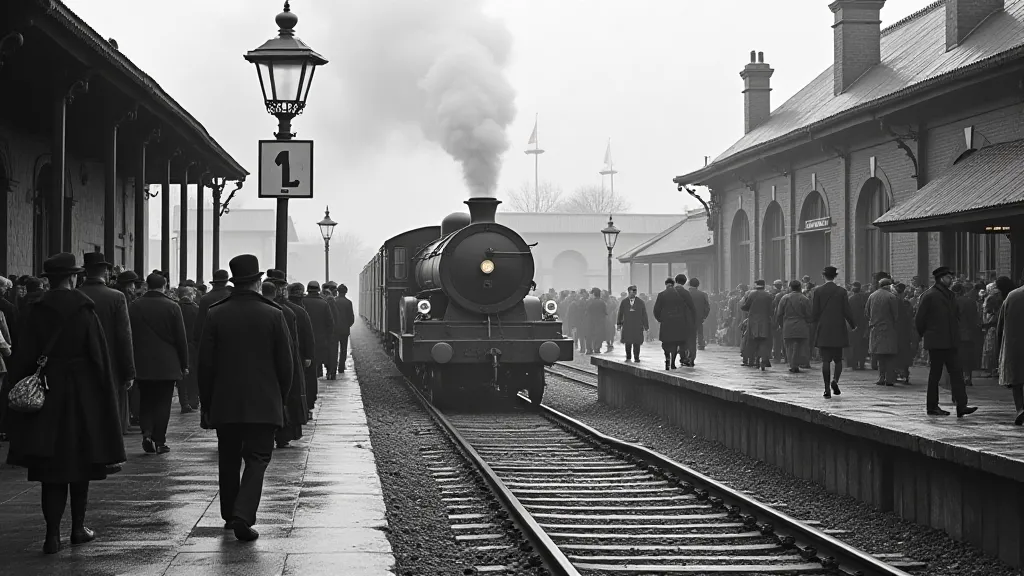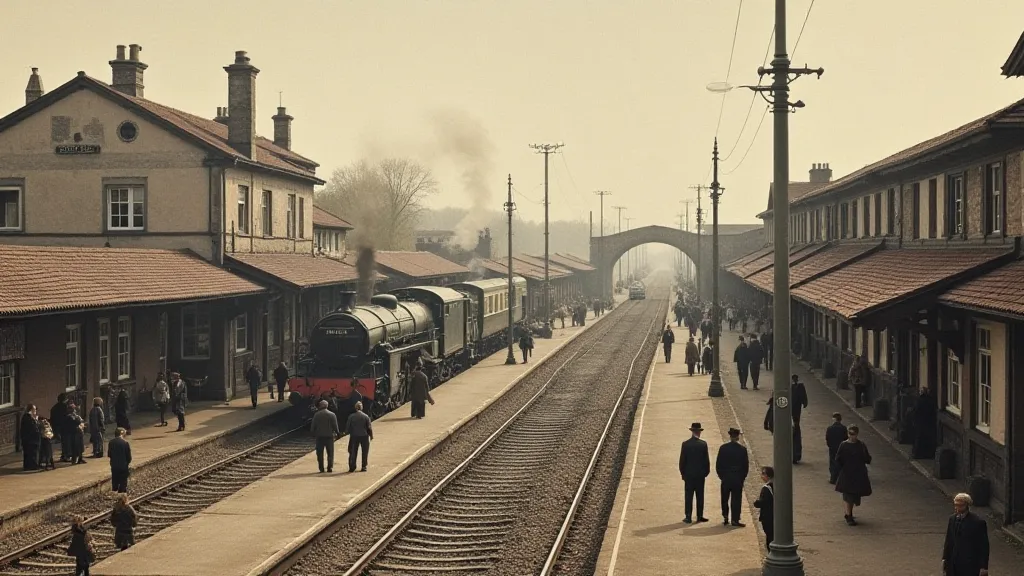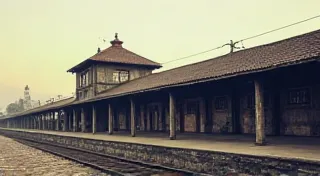The Railway Station: Connecting the Region
Description: Uncover the story of the Railway Station, a vital transportation hub that shaped the region’s growth. Learn about its construction, its impact on commerce, and its eventual decline.
A Line of Progress: Early Days
Before the railway arrived, travel within our region was a slow and arduous process. Stagecoaches and river barges were the primary means of transport, limiting the movement of goods and people. The arrival of the railway in [Year] marked a turning point, fundamentally altering the region's landscape and economy. The decision to build a station in [Location] was strategic; it positioned the area as a key logistical center, attracting businesses and settlers. It’s hard to imagine a time without such ease of transportation – life for early settlers and those working the land was far more challenging, and stories of their perseverance are lovingly preserved, much like the railway station itself. For a glimpse into their daily lives and the challenges they faced, explore the fascinating story of the Pioneer Farmstead. The isolation of those early days, before reliable transportation routes were established, profoundly shaped the character of the community and its connection to the wider world.

Construction and Design
The original railway station was a testament to Victorian architectural ambition. Constructed primarily from locally sourced [Stone/Brick], its design reflected the prevailing aesthetic of the time: grand, imposing, and functional. The building featured [Describe architectural details: arched windows, a high clock tower, ornate detailing]. The platform extended [Length] and could accommodate [Number] trains simultaneously. The architects, [Architects' Names - if known], aimed to create a lasting symbol of progress and connectivity. The sheer scale of the undertaking and the intricate detailing reflected a period of unprecedented growth and optimism. The ambition extended beyond mere functionality; it was about creating a landmark that would inspire pride and confidence within the burgeoning community. The railway's influence wasn’s limited to transportation; it fostered a sense of community and connection that resonated throughout the region. This spirit of preservation extends beyond the railway station itself, as local organizations strive to protect and showcase other landmarks that tell the region’s story. Consider visiting the Regional Museum to delve deeper into this rich heritage. The intricate detail and grandeur of the station’s design mirrored a broader movement towards showcasing prosperity and ambition throughout the region – a trend that could also be observed in other prominent structures of the era.

The Engine of Commerce
For decades, the railway station served as the region’s vital artery, pumping lifeblood into its economy. It facilitated the transport of [Goods transported: agricultural products, timber, manufactured goods] to larger markets, connecting local producers with wider opportunities. The increased accessibility spurred the growth of local industries. Businesses thrived, and new settlements sprung up along the railway line, transforming the region’s character. The station also became a social hub, a place where people gathered to greet arriving loved ones or bid farewell to those departing. The railway’s influence wasn’t solely about trade; it spurred significant architectural endeavors, reflecting the region’s burgeoning prosperity and ambition. The design itself was often inspired by the grand estates of the era, demonstrating a desire to showcase the region’s growing importance and wealth. The ripple effect of the railway’s success was felt across various sectors, contributing to the overall growth and development of the area. This mirroring of prosperity and design philosophies can be further explored by examining other historic landmarks in the area, such as the opulent Story of Oakhaven Manor. The connection between a flourishing economy and impressive architectural achievements is a recurring theme throughout the region’s history, and the railway station stands as a prime example.

Decline and Adaptation
The mid-20th century brought significant changes. The rise of automobiles and the development of the highway system gradually diminished the railway’s dominance in transportation. Passenger numbers declined, and freight traffic slowed. By [Year], the original station building faced the threat of demolition. The shift towards highway transportation wasn’t solely about convenience; it also reflected a broader societal change in priorities and a move away from centralized transportation hubs. The eventual impact on the station, and the subsequent efforts to preserve it, are a testament to the community’s commitment to remembering its past. The decline wasn't abrupt but a gradual erosion of reliance, reflecting changing economic and social landscapes. The convenience of personal vehicles provided a level of flexibility that the railway simply couldn’t match. Detailed research into the factors influencing this shift would reveal a complex interplay of economic forces, technological advancements, and changing consumer preferences. The survival of the station and its preservation stand as a powerful symbol of the community's resolve to retain its history. The ease of travel offered by highways also impacted other infrastructure, with a similar reduction in reliance on the region’s Historic Bridge, a critical link for commerce before the rise of automobile transport.
However, a concerted effort by local preservationists led to its restoration. The preservation process itself was a monumental undertaking, requiring significant funding and expertise. Detailed architectural plans were meticulously studied, and original materials were sourced whenever possible. The dedication of the preservation team ensured that the station’s character and historical significance were faithfully recreated. It wasn't just about fixing a building; it was about safeguarding a tangible link to a bygone era. The challenges involved highlight the complexities of preserving historical structures and the importance of community involvement in safeguarding our cultural heritage. The work undertaken was far more than a simple renovation; it was a carefully considered act of cultural stewardship, ensuring that the station’s legacy would endure for generations to come. Understanding the nuances of this preservation effort requires a deep appreciation for the craftsmanship and dedication involved, as well as an understanding of the historical context that shaped the building’s design and significance.
Preserving the Legacy
Today, the building serves as [Current use: museum, community center, shops]. While passenger rail service may be limited or non-existent, the station remains a beloved landmark, a tangible reminder of a bygone era when the clang of the train whistle signaled progress and prosperity. The architectural details, carefully preserved, continue to tell the story of the region’s connection to a wider world. The preservation efforts extend beyond the physical structure of the building; they also encompass the stories and memories associated with it. Oral histories, photographs, and artifacts are collected and displayed to provide visitors with a comprehensive understanding of the station’s role in the region’s history. This holistic approach to preservation is essential for ensuring that the station’s legacy continues to inspire and educate future generations. The continued existence of this important landmark is indicative of a wider cultural commitment to preserving the region's rich past. The resilience of this historic structure is a powerful illustration of the community’s determination to maintain a connection to its roots. The spirit of community investment and stewardship extends to other places of interest, ensuring their protection for future exploration and appreciation.
Efforts are ongoing to ensure that the railway station’s story continues to be told. Local historical societies organize tours and events, educating visitors about the station’s significance. The building’s preservation serves as a symbol of the community’s commitment to honoring its past while embracing the future. Detailed research continues to uncover new information about the station’s history, enriching the narrative and providing a deeper understanding of its impact on the region. Volunteers dedicate countless hours to maintaining the building, ensuring that it remains a vibrant and engaging space for visitors. The ongoing preservation efforts are not just about preserving a building; they are about sustaining a community's identity and ensuring that future generations can connect with their heritage. The railway station represents more than just a transportation hub; it’s a symbol of progress, connection, and the enduring spirit of the region. It stands as a testament to the power of collective memory and the importance of preserving our shared history. The echoes of the past resonate within its walls, reminding us of the people who shaped our community and the challenges they overcame. The station’s enduring presence serves as a beacon of hope, inspiring us to learn from the past and build a brighter future.





